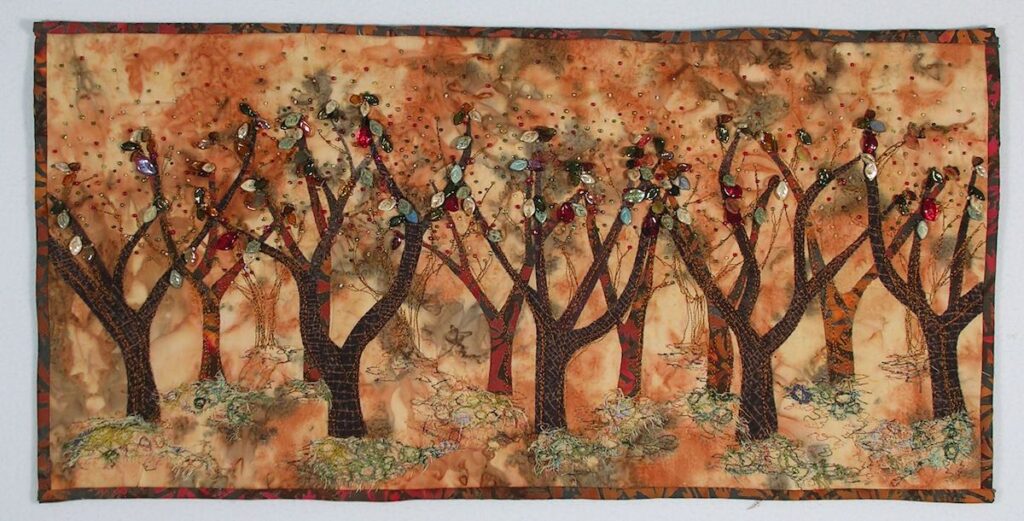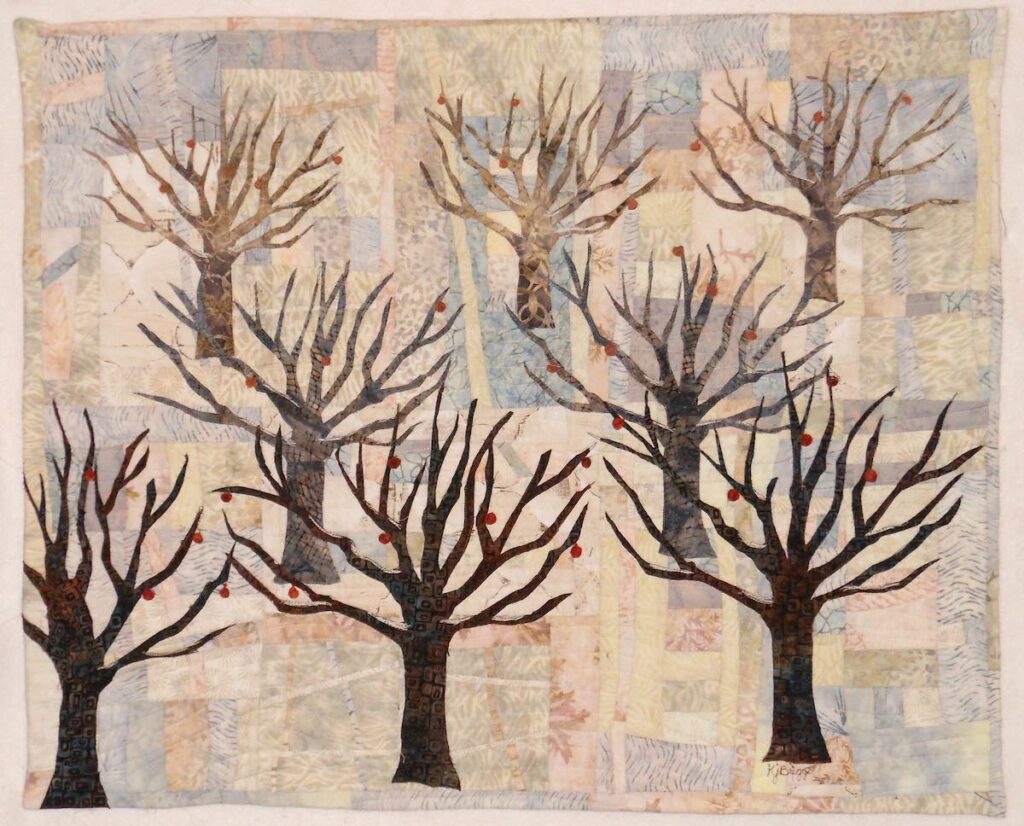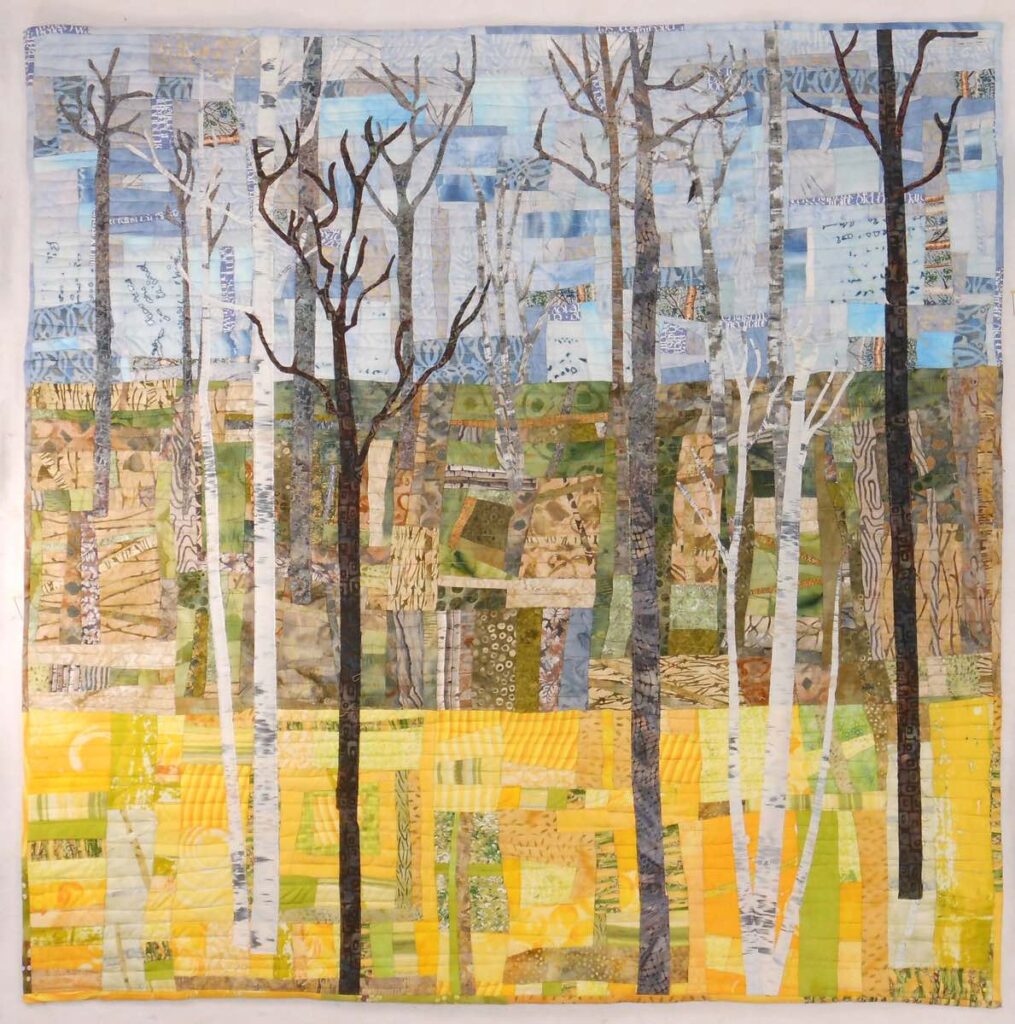
When textile artist Kathie Briggs sits down to create an art quilt, there is a good chance it will focus on trees. And her signature pieced background will set the work apart with subtle interplays of color and texture. Working from her studio in her family’s home in the woods, Kathie has endless inspiration just outside her door.
How did you find yourself on an artist’s path? Always there? Lightbulb moment? Dragged kicking and screaming? Evolving?
I think I’ve always thought of myself as an artist. What a trip down memory lane! Some of my earliest memories involve crayons, scissors, yarn and paste. I simply loved making things and had a lot of encouragement at home. When I was five my grandmother enrolled me in an art program at the Detroit Institute of the Arts. One of the projects I remember best was a puppet with a paper maché head and cloth body.
My school didn’t have art classes. Nevertheless, I was always drawing or making something. I loved to sew and was thrilled to learn to use a sewing machine when I was 11. I started making some of my clothes in the 7th grade and continued to sew clothing through college and for several years beyond. In high school and college I made elaborate Christmas ornaments with ribbons, beads and sequins over Styrofoam balls. Family members still send me photos of their ornaments on their Christmas trees so they have held up well. Later I tried a lot of crafts: needlepoint, découpage, dollhouse miniatures, embroidery, etc.

What motivates you artistically? What is it about a subject that inspires you to continue exploring it?
As an Amazon Associate I earn from qualifying purchases. Read more about our affiliate linking policy.
Nature inspires me. I spend a lot of time outside. I’ve been blessed to live amid beautiful surroundings in Northern Michigan and here in Western North Carolina. Nature provides endless paths to explore through art. I’ve worked in a number of nature inspired series: weeds, water and shore birds, plants and their pollinators, botanical prints, and of course trees. Of all of these trees, feature most predominately in my work.
And what is it about trees? It’s a feeling I can’t adequately put into words. To me they represent strength and patience. They provide shelter and food for birds, insects, animals and people. They produce oxygen and shade and their wood is their last gift.
The first tree drawing I remember is one I made in the 4th grade the day we had a substitute teacher. It was autumn and the maple behind the school was changing, so she took us outside and gave us a sheet of manila paper and crayons. I oriented my paper in landscape mode and carefully drew the tree with all of its limbs and branches. I placed a portion of of the school building in the background and worked hard to get the perspective correct.
Well, at the end of the day, after praising several drawings that looked like lollipops, the teacher held my drawing up in front of the class and told everyone what was wrong with it. Lucky for me that my Mother was a better critic than the sub. She told me substitute teacher was wrong and not to pay attention to her. So I kept drawing trees. And most of my art pieces to this day feature trees or reference them in botanical studies.

Why fiber? How does that medium best express what you want to communicate through your art?
Working with textiles just seemed to be the most natural way to express myself. It seems I’ve always worked with fabric, from the time I hand sewed little dresses for my dolls and cut down my own outgrown dresses to make costumes for my little sister. Fabric has both a visual and tactile texture and I enjoy using both to create the imagery. I love the feel of the fabric in my hands while I’m working. Have you ever noticed that viewers seem to want to touch fiber pieces? You don’t see them touching paintings. There’s something elemental about fabric. Something that touches on some of our earliest memories of comfort and security.

What do you do differently? What is your signature that makes your work stand out as yours?
The background technique I often use seems to be what defines much of my work. It evolved over several years as I attempted to create depth and movement in the background. I began by using hand-dyed and batik fabrics that would approximate this but continued looking for something with more energy. I began making pieced backgrounds around 2008 after seeing Gwen Marston’s quilt, “Red Sticks”, made from red blocks with various narrow strips of fabric inserted at different angles. Its a striking quilt and I thought her insertion technique in a more muted palette would give me the look I wanted. I used this insertion technique for quite a while, often color blocking the backgrounds.
A few years later I bought Rayna Gillman’s book on free-piecing. First I experimented with using lots of colors and creating abstract quilts. Amazingly these sold very well in gallery. They were fun but really not “me”. I adapted the free-piecing methods to my own palette and that’s what I continue to use as backgrounds for most of my quilts.

How has your creativity evolved over the years? What triggered the evolution to new media/kinds of work/ways of working?
I worked in a variety of day jobs of the left-brain variety, but I always had some kind of art project at home. One day at an art fair I came across the most intriguing fiber art dolls. I was captivated. My husband suggested that instead of purchasing them that I could make them myself. So I found an online course in dollmaking. The instructor’s dolls were not the style I wanted to make, but they were very well constructed and I was interested in learning sound construction techniques.
I went on to design my own fabric art dolls. I developed a small line of patterns and taught dollmaking at doll conferences, quilt guilds and shops. At one quilt shop I came across art quilts for the first time. I had always loved quilts but the idea of making the same block over and over again did not appeal. This was different. This was my “Lightbulb Moment”
I started out making small collage type pieces. I joined an online group. We made monthly “Journal Quilts” and exchanged fabric postcards. The small scale projects and challenges gave me an an opportunity to explore a wide variety of techniques and themes. Around this time I left my day job and moved from the suburbs to the north woods. I was lucky to meet a couple of fiber artists who introduced me to the Studio Art Quilt Associates (SAQA). The dolls had taught me a lot, and it was time to move onto something new. And with art quilts there is always something new to explore. Twenty-some years later I have yet to run out of ideas.

When it comes to creating, are you more of a planner or an improviser?
I’m a bit of both. When I start a piece I have a general idea where I’m headed. I usually review a lot of photographs, my own and others, of the subject and make sketches before I begin. I spend a great deal of time selecting the fabrics I plan to use. Before constructing imagery, I create the background. I find that while I’m free-piecing the background the improvisation often leads me to shift the palette or rethink the composition. At some point the piece will usually tell me what it wants me to do. I’ve learned to listen to the piece rather than imposing my will on it

Do you have a dedicated space for creating? If so, what does it look like?
I have a wonderful studio space. In its former life it was a large family room. In fact it was the the main reason we bought this house. I have three sewing machines set up as well as large cutting and pressing tables. It’s an eclectic mix of antiques and re-purposed furniture that feels homey. Most of my fabric is stored in clear boxes housed in an Ikea bookcase. There’s a small kitchenette that’s my wet studio. At one end I have a large design wall and a little office space.
I look out over the garden to the woods beyond. There’s even an old tobacco barn just beyond our back fence. My husband’s large wood shop is adjacent which is handy when I need to borrow a tool. I even have a small covered deck right off my studio. Handy for those projects that should be done outdoors and a wonderful place to sit and do hand-work. I truly love my studio. My cats love it too so I have a large cat tree for them.

What are the indispensable tools and materials in your studio? How do they improve your work?
A few years ago I received a commission from a hospital to recreated a couple of my pieces in larger scale in a rather tight time frame. I purchased a Brother Scan and Cut machine so I could scan my tree drawings and then cut them in different sizes and in mirror image. It not only saves time but the cutter gives me cleaner edges than I could achieve with scissors. I’ve since used it for trees, leaves and insects.
Misty Fuse in a product I could not do without. I use it to fuse all my designs to my pieced and quilted backgrounds. It does not change the hand of the fabric nor gum up the machine, so I love it. I can build an image from components by temporarily heat tacking the pieces to parchment paper. Then I can peel off the image and arrange it on my background.

Can you tell us about the inspiration and process of one of your works? How does a new work come about?
I’m often asked how long it takes me to create a piece. There’s never an easy answer to that. For “A Year in the Forest” however the answer is “about 20 years”. The inspiration came from a dream I had in 2000. Its was not the first time a dream inspired a piece but it was the most challenging. What I can remember from the dream was that I was in a creative space with other artists. I was working at a design wall and depicting the change of seasons in a forest. Of course I couldn’t recall exactly what the piece looked like, only what it was about.
Over the years I attempted to recapture the dream piece but couldn’t quite come up with right imagery. I thought I came close in 2007 with a piece called “Cycles” which depicted one tree in four different seasons. In 2020 I decided to see if I could make the background of a quilt show the change of seasons, then place trees across the background. Once I started working on it I felt I had captured the dream piece. I entered it into our guild show where it won a ribbon and found a new home. It remains one of my favorite pieces because I loved the process of making it.


And It was not the end of my tree series. A couple of months ago I received an inquiry from an architectural firm for a large piece for their conference room. They wanted something similar to “A Year in the Forest” but with a less vibrant background. We agreed that a gradation of greens would create the ambiance they were looking for. Creating this piece was a joy as it combined my favorite color (green) with my favorite theme (trees) and my favorite technique (free-piecing). “Quiet Forest” took 2 months to complete. It is 71” x 34”. And its is not the end of my tree series. The next one is on the drawing board.
Learn more about Kathie and see more of her art https://kathiebriggs.com/.
Interview posted February 2022
Browse through more inspiring art quilts on Create Whimsy.

